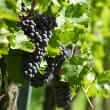Background
- Grape leaves, sap and fruit have been used medicinally since the time of the Greek empire. Preparations from different parts of the plant have been used historically to treat a variety of conditions, including skin and eye irritation, bleeding, varicose veins, diarrhea, cancer and smallpox.
- Interest in grape products for heart disease prevention increased with reporting of possible protective effects from wine consumption in French men who also consume a high fat diet (the so-called "French paradox"). However, well-designed controlled trials of the proposed active component of grape seed extract (GSE), the oligomeric proanthocyanidins (OPCs), are lacking. It is important to note that grape seed extract and Pycnogenol® are not the same even though they both contain oligomeric proanthocyanidins. Pycnogenol® is a patented nutrient supplement extracted from the bark of European coastal pine Pinus maritima.
- The antioxidant properties of OPCs have made products containing these extracts candidate therapies for a wide range of human disease. Randomized, controlled trials have documented the effectiveness of OPCs from grape seed in relieving symptoms of chronic venous insufficiency, injury related extremity edema, diabetic retinopathy, arteriosclerosis and high blood pressure. Grape seed extract has been used by natural practitioners in Europe to treat venous insufficiency, promote wound healing, alleviate inflammatory conditions, and as a "cardioprotective" therapy.
- OPCs appear to be well tolerated with few side effects noted in the available literature. However, long-term studies assessing safety are lacking.
References
Natural Standard developed the above evidence-based information based on a thorough systematic review of the available scientific articles. For comprehensive information about alternative and complementary therapies on the professional level, go to . Selected references are listed below.
- Amsellem M, Masson JM, Negui B, et al. [Endotelon in the treatment of venolymphatic problems in premenstrual syndrome. Multicenter study on 165 patients]. Tempo Medical 1987;282 :46-51.
- Banerjee B, Bagchi D. Beneficial effects of a novel ih636 grape seed proanthocyanidin extract in the treatment of chronic pancreatitis. Digestion 2001;63(3):203-206.
View Abstract - Bernstein CK, Deng C, Shuklah R, et al. Double blind placebo controlled (DBPC) study of grapeseed extract in the treatment of seasonal allergic rhinitis (SAR). J Allergy Clin Immunol 2001;107(2):s311.
- Brooker S, Martin S, Pearson A, et al. Double-blind, placebo-controlled, randomised phase II trial of IH636 grape seed proanthocyanidin extract (GSPE) in patients with radiation-induced breast induration. Radiother Oncol. 2006 Apr;79(1):45-51.
View Abstract - Lesbre FX, Tigaud JD. [The effect of Endotelon on the capillary fragility index of a specified controlled group: cirrhosis patients]. Gazette Medicale de France 1983;90(24):2333-2337.
- Nuttall SL, Kendall MJ, Bombardelli E, et al. An evaluation of the antioxidant activity of a standardized grape seed extract, Leucoselect. Journal of Clinical Pharmacology and Therapeutics 1998;23:385-389.
- Oshima Y, Namao K, Kamijou A, et al. Powerful hepatoprotective and hepatotoxic plant oligostilbenes, isolated from the Oriental medicinal plant Vitis coignetiae (Vitaceae). Experientia 1-15-1995;51(1):63-66.
View Abstract - Petrassi C, Mastromarino A, Spartera C. Pycnogenol in chronic venous insufficiency. Phytomedicine 2000;7(5):383-388.
View Abstract - Preuss HG, Wallerstedt D, Talpur N, et al. Effects of niacin-bound chromium and grape seed proanthocyanidin extract on the lipid profile of hypercholesterolemic subjects: a pilot study. J Med 2000;31(5-6):227-246.
View Abstract - Rimm EB, Williams P, Fosher K, et al. Moderate alcohol intake and lower risk of coronary heart disease: meta-analysis of effects on lipids and haemostatic factors. BMJ 1999;319(7224):1523-1528.
View Abstract - Skovgaard GR, Jensen AS, Sigler ML. Effect of a novel dietary supplement on skin aging in post-menopausal women. Eur J Clin Nutr. 2006 Oct;60(10):1201-6.
View Abstract - Snow LA, Hovanec L, Brandt J. A controlled trial of aromatherapy for agitation in nursing home patients with dementia. J Altern Complement Med 2004;10(3):431-437.
View Abstract - Spadea L, Balestrazzi E. Treatment of vascular retinopathies with Pycnogenol. Phytother Res 2001;15(3):219-223.
View Abstract - Vaswani SK, Chang BW, Carey RN, et al. Adult onset grape hypersensitivity causing life threatening anaphylaxis. Ann Allergy Asthma Immunol. 1999;83(1):25-26.
View Abstract - Yamakoshi J, Sano A, Tokutake S, et al. Oral intake of proanthocyanidin-rich extract from grape seeds improves chloasma. Phytother Res 2004;18(11):895-899.
View Abstract







